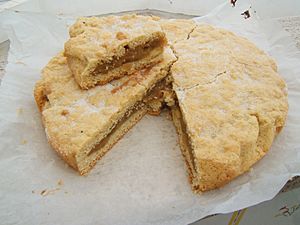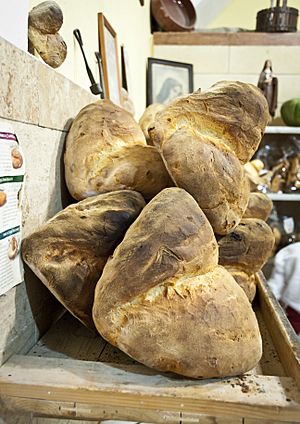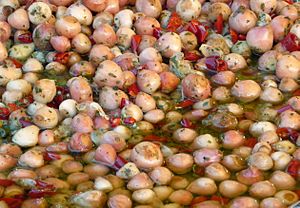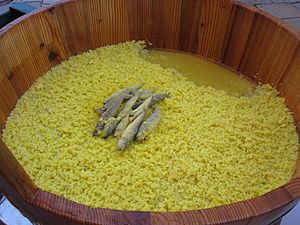Apulian cuisine facts for kids
Apulian cuisine is the delicious food from the Apulia region in Italy. Long ago, rich families didn't live in Apulia much, so their fancy cooking styles faded away. Most people were not wealthy, so their food became simple and affordable. Bread, vegetables, and pasta are super important in Apulian meals. People also eat lots of fruit, fish, and drink wine, but meat is less common. Apulian food is often called cucina povera, which means 'cuisine of the poor'. But this just means it's simple, not that it's not tasty! In fact, the simple dishes let the amazing local and fresh ingredients really shine.
Contents
Fun Food Festivals: Sagre
Apulia has special food festivals called sagre. These festivals show off local foods, cooking traditions, and culture. While other parts of Italy have sagre, they are a huge part of Apulia's identity. These events are very social, and you can eat alongside local people and enjoy the delicious food.
How Apulian Food Became Simple
After the time of Magna Graecia (ancient Greek settlements), Apulia was never an independent region. It was always part of a bigger state. From the Middle Ages until Italy became one country in the 1800s, Apulia was ruled by the Kingdom of Naples. Its capital was Naples in Campania.
The wealthy landowners in Apulia preferred to live in Naples. If they visited Apulia, it was only for short trips to check on their land. Because of this, the fancy cooking of the rich slowly disappeared in Apulia. Even the food from monasteries, which were many in Apulia, didn't become part of local traditions. Monasteries helped the poor, and the food they gave was mostly simple soups.
Because of these reasons, the food of everyday people became what defines Apulian cooking. Apulia was a poor region for a long time. This meant ingredients had to be cheap, local, and in season. This focus on saving money made vegetables very important. Dishes are simple, without complicated steps. Apulian food is often called "peasant food" or cucina povera (food of the poor). But even with simple ingredients and cooking, the dishes are often richer and more flavorful than you might think!
In modern times, Apulian meals have appetizers, first courses, and second courses. Eating separate courses is quite new. In the past, a meal was usually just one big dish. Many appetizers today were once full meals themselves. Some first courses are still very filling, showing they used to be the only dish for a whole meal.
Tasty Apulian Foods
Snacks and Appetizers
Many snacks and appetizers in Apulia are made with bread. The puccia is a small, flat, round bread. Some have olives mixed in the dough. The plain puccia is cut open and filled with vegetables, meat, or seafood. The panzerotto is a pastry filled with different things. A popular filling is tomato and mozzarella cheese. They are like the calzone from Naples but smaller and use a softer dough. They can be baked, but frying them is the traditional way. Focaccia Barese is a local type of focaccia from Bari. It's topped with tomatoes, oregano, and sometimes olives, with olive oil drizzled over it.
The rustico, popular in Lecce, uses puff pastry instead of bread. It's filled with béchamel sauce, mozzarella, and tomato sauce, then baked. Scagliozzi might be the only popular way to eat polenta in Apulia. Polenta is cooked, then cooled and dried. It's cut into slices and deep-fried. Pettole are deep-fried croquettes made from a liquid batter of flour and yeast, sometimes with boiled potatoes. They can be savory with fish or vegetables, or sweet.
Taralli are popular ring-shaped crackers. They are made with flour, olive oil, white wine, and salt. The classic ones have fennel seeds, but there are many kinds, both savory and sweet. You can eat them plain or dip them in wine.
Bread, a Staple Food
Bread is a very important part of the Apulian diet. Most of the wheat grown in Apulia is durum wheat. This is why many breads are made fully or partly with durum wheat. The most famous breads are Pane di Altamura, Pane di Laterza, and Pane di Monte Sant'Angelo. Pane di Altamura is so special it has a protected status in Europe. It's made only with durum wheat flour, just like Pane di Laterza. Pane di Monte Sant'Angelo is different because it's traditionally made with common wheat flour.
Frisella is a bread that lasts a long time, so it's a good choice when fresh bread isn't available. It's shaped like a ring with a hole, which made it easy to string them together for storage. The dough is made with wheat, durum, or barley flour. After baking it once, the frisella is cut in half horizontally. Then it's baked again until it's completely dry. Before eating, you soak it in water until it's soft but still a bit firm. Then you add different toppings.
Apulians also have clever ways to use stale bread instead of throwing it away. Cialledda, also called aquasale, is one example. Stale bread is soaked in water to soften it. Then it's mixed with tomatoes, olive oil, and salt. The dish pancotto is similar but has more ingredients. Stale bread is also used to make dry breadcrumbs. These can be sprinkled on top of many dishes.
Cheeses of Apulia
The most famous Apulian cheese around the world is fresh burrata. This cheese has an outer shell of mozzarella filled with creamy stracciatella. Only burrata di Andria has a special protected status in Europe. Other important Apulian cheeses include aged caciocavallo Silano, canestrato Pugliese, and fresh mozzarella di bufala Campana. You can also find caciocavallo podolico, cacioricotta Pugliese, pallone di Gravina, and different types of ricotta. Ricotta forte has a very strong flavor.
Fruits and Olive Oil
Like other parts of Southern Italy, olive oil is the main cooking fat. Today, table olives are often served as appetizers. But in the past, they were even more important, sometimes being the only food available besides bread. Apulia makes the most olive oil and table olives in Italy, with many local types. Five of these olive oils and one type of table olive have special protected status.
Many sweet fruits are enjoyed as dessert after a meal. The arancia del Gargano (an orange) and clementine del Golfo di Taranto (a clementine) have protected status. The limone femminello del Gargano (a lemon) also has a special protected status. The fruit of the prickly pear cactus, which grows all over the countryside, is also eaten.
Warming Soups
Soups are very popular, especially in winter. Vegetables and legumes (like beans) play a big role, often with short pasta shapes. Bread is also often included, either on the side or mixed into the soup. The bread dishes cialledda and pancotto can become soups if you add vegetable broth. A soup from the Salento area is called cecamariti, which means 'blinding the husband'. It got this name because it looks impressive, but it's actually easy to make! There are also fish soups, which have a rich broth from small fish cooked with their bones.
Pasta, Apulia's Signature Dish
In Northern Italy, eggs are a key ingredient for pasta. But in Apulia and other parts of Southern Italy, pasta is made only with semolina flour and water. This was mainly for economic reasons, as eggs were too valuable for everyday pasta. Not using eggs in pasta dough meant they could be used in other dishes.
Orechiette is considered the most famous pasta shape of Apulia. But there are many others, like cavatelli, capunti (from the Murgia plateau), troccoli (from the Daunia), lagane, and sagne. Orrechiette is often served with fried cime di rape (turnip greens) in a dish called orrechiette con le cime di rape. Besides common pasta dishes with tomato sauces, meat, or seafood, there are unique Apulian combinations with vegetables. For example, ciceri e tria uses chickpeas, and lagane con puré di fave uses broad bean puree.
Pasta can also be made with grano arso, which means 'burnt grain'. In the past, after the grain harvest, any leftover grains were gathered from the fields after the stubble was burned. This was done out of extreme poverty. Today, pasta made with grano arso is seen as a special treat.
Wonderful Vegetables
Broad beans and cime di rape are the most famous vegetables of Apulia. The broad bean has been a staple food in the region for thousands of years. When dried and split, it's the main ingredient of the famous dish fave e cicoria. Other common vegetables include fennel, zucchini, artichoke, bell peppers, cauliflower, eggplant, wild leaf chicory, the cardoncello mushroom, and broccoli. The carciofo Brindisino (artichoke) and lenticchia di Altamura (lentils) have special protected status from the EU.
Many vegetables are preserved using the sott'olio method, which means 'under the oil'. First, vegetables are boiled in white wine vinegar. Then they are mixed with spices and herbs and placed in jars. The jars are filled with olive oil to cover the vegetables completely, so they don't touch the air. This way, the vegetables can be kept for up to a year and their flavor gets even better.
Apulian cooking also uses some less common vegetables. The tassel hyacinth grows wild and its bulb is used. Known as lampascioni in Apulia, these are usually boiled and seasoned with olive oil, vinegar, salt, and black pepper. They can also be grilled or deep-fried.
The black chickpea (ceci neri) was eaten more often before the 1950s. But its production dropped because farmers grew more profitable crops. Today, it's mainly grown in the Murgia plateau. Black chickpeas have a stronger taste than white ones. They are often just boiled and served with oil, sometimes with small pasta.
The grass pea (cicerchia) was popular in cookbooks from the 1600s. But it became less common because the plant doesn't produce much and can be harmful if eaten as a main food. Recently, this crop has been rediscovered and is grown in the Alta Murgia and Salento. It's used in soups and stews.
Fresh Seafood
Apulia is a peninsula, meaning it's surrounded by sea on three sides. So, the sea is always close by! This makes seafood a very important part of its food. There's a huge variety of seafood available, including sea bream, octopus, prawns, oysters, anchovies, mussels, and clams. Some people even compare Apulia to Japan because of its love for raw fish.
One popular dish is tiella. This is a slow-cooked dish with layers of rice, potatoes, and mussels. This version comes from Bari. But there are many local variations, with different recipes from Foggia, Taranto, and Salento. Some of these don't even include seafood! Scapece is a fish dish from Gallipoli, Apulia known for how it's preserved. Like escabeche, fish is fried and then kept in red wine vinegar with breadcrumbs and saffron. This helps it last a long time. Some dishes use dried and salted cod (baccalà), which is one of the few imported ingredients.
Meat Dishes
In the past, meat was expensive and hard to get. So, it's not a huge part of Apulian cuisine. Beef was almost never eaten in the past. Cattle were used for farm work or for milk, and only slaughtered when they were very old. Similarly, horse meat was eaten because lame horses that couldn't work anymore were slaughtered. Lamb, poultry (like chicken), and rabbit (often raised on farms) were the main types of meat. Sometimes, game meat was also eaten. A farm usually raised one pig, and every part of it would be used when it was slaughtered. Some meat was eaten fresh, but most was preserved as ham, sausages, and salami.
The Apulian recipe for ragù (a meat sauce) is different from other Italian regions. Traditionally, it uses sun-dried tomato pulp as a base. This is fried in olive oil with water, fresh tomatoes, and sometimes chili pepper and red wine. Then meat braciole (or involtini, which are rolled meat slices) are added. These can be used with the sauce to dress pasta dishes. Besides good cuts of meat, there are also recipes that use offal (like internal organs) in rolled dishes and pig's trotters.
Sweet Treats

The ingredients for Apulian sweets are sometimes influenced by the Middle East. They include almonds, figs, hazelnuts, pistachios, and spices. The traditional sweetener is honey, which is still used a lot. Fresh, soft ricotta cheese is also used in desserts.
Apulian Wine
In 2017, Apulia became the biggest wine-producing region in Italy! It made over 9 million hectoliters of wine. For ages, Apulia produced grapes with high alcohol content. These were used by other regions in Italy and France to mix with their own wines. Since the 1990s, Apulian winemakers have been trying new and exciting techniques. Today, Apulia makes wines from many different local grape varieties. The most famous wine internationally is Primitivo di Manduria. But there are many other great types like Negroamaro, Bombino Bianco, Pampanuto, Verdeca, Bianco d'Alessano, and Susumaniello.
See also
 In Spanish: Gastronomía de Apulia para niños
In Spanish: Gastronomía de Apulia para niños







